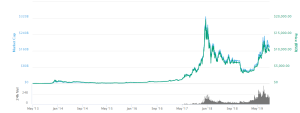Bitcoin Price Volatility: A Multifaceted Analysis
Unravel the mysteries of Bitcoin’s price swings! Discover how macroeconomic trends, tech advancements, and market sentiment all contribute to its wild ride. Learn to navigate the crypto rollercoaster!
Bitcoin’s price is notoriously volatile, experiencing dramatic swings in value within short periods․ Understanding these fluctuations requires examining a complex interplay of factors, from macroeconomic trends to specific technological developments and market sentiment․ No single reason definitively explains any given price movement․ Rather, it’s the confluence of various contributing elements that drives Bitcoin’s ascent or descent․
Macroeconomic Factors Influencing Bitcoin’s Price
Global economic instability often acts as a catalyst for Bitcoin’s price increases․ When traditional markets experience uncertainty, such as during periods of high inflation or geopolitical turmoil, investors may seek alternative assets perceived as safe havens․ Bitcoin, despite its own volatility, has gained traction as a potential hedge against inflation and a store of value, independent of traditional financial systems․ This increased demand, fueled by uncertainty in traditional markets, can drive the price upwards․
Interest rate hikes by central banks, intended to combat inflation, can also indirectly impact Bitcoin’s price․ Higher interest rates generally reduce the attractiveness of riskier assets, including cryptocurrencies․ However, if inflation remains high despite these measures, the appeal of Bitcoin as an inflation hedge can outweigh the impact of higher interest rates, leading to price increases․
Inflation and the Search for Safe Havens
High inflation erodes the purchasing power of fiat currencies․ In such environments, investors seek assets that retain their value or even appreciate over time․ Bitcoin, with its limited supply of 21 million coins, is often viewed as a deflationary asset, potentially offering protection against inflationary pressures․ This perception can significantly boost demand and consequently, its price․
Geopolitical Uncertainty and Bitcoin’s Appeal
Periods of geopolitical instability, such as wars, political upheavals, or international sanctions, can cause investors to flee traditional markets in search of safer investments․ Bitcoin, being decentralized and beyond the control of any single government or institution, can become an attractive refuge during such times․ The increased demand during these periods can lead to a substantial price surge․
Technological Advancements and Market Sentiment
Technological developments within the Bitcoin ecosystem can also influence its price․ Upgrades to the Bitcoin network, such as improvements in transaction speed or scalability, can enhance its usability and attract more users and investors․ Conversely, significant security breaches or technological setbacks can negatively impact investor confidence and lead to price drops․
Network Upgrades and Scalability Improvements
The Bitcoin network is constantly evolving․ Upgrades aimed at improving transaction speed, reducing fees, or enhancing scalability can make Bitcoin a more attractive option for a wider range of users․ This increased adoption can, in turn, lead to higher demand and a price increase․
Regulatory Developments and Their Impact
Regulatory clarity or favorable legislation regarding Bitcoin in major economies can boost investor confidence and lead to price appreciation․ Conversely, stricter regulations or crackdowns on cryptocurrency trading can negatively impact the market and depress prices․ The regulatory landscape is constantly shifting, making it a significant factor in Bitcoin’s price volatility․
Market Sentiment and Speculation
Market sentiment plays a crucial role in Bitcoin’s price fluctuations․ Positive news, such as adoption by major corporations or positive pronouncements from influential figures, can generate significant buying pressure and drive prices upwards․ Conversely, negative news or widespread fear can lead to sell-offs and price declines․
Speculation also significantly influences Bitcoin’s price․ The limited supply of Bitcoin, combined with its potential for future appreciation, attracts speculators who bet on its price increasing․ This speculative activity can create price bubbles and contribute to its volatility․
Social Media Influence and News Cycles
Social media platforms and news cycles exert a considerable influence on market sentiment․ Positive or negative news coverage, along with tweets or posts from influential figures in the cryptocurrency space, can create waves of buying or selling pressure, leading to significant price swings․ The speed and reach of modern media amplify this effect․
Whale Activity and Market Manipulation
Large Bitcoin holders, often referred to as “whales,” can exert significant influence on the market․ Their buying or selling activity can trigger substantial price movements, sometimes leading to accusations of market manipulation․ While regulatory bodies are working to mitigate such risks, the impact of whale activity remains a significant factor in Bitcoin’s price volatility․
Other Factors Contributing to Bitcoin’s Price
- Adoption by Institutional Investors: Increased investment from large financial institutions adds legitimacy and liquidity to the market, often pushing prices higher․
- Mining Difficulty Adjustments: Changes in the difficulty of mining Bitcoin affect the rate of new coin creation, influencing supply and demand․
- Competition from Other Cryptocurrencies: The emergence of new cryptocurrencies with potentially superior features can divert investment away from Bitcoin, impacting its price․
- Global Economic Growth: Periods of strong global economic growth can boost investor risk appetite, leading to higher demand for Bitcoin and other riskier assets․
- Technological breakthroughs in blockchain technology: Advancements in blockchain technology can improve the efficiency and scalability of Bitcoin, potentially increasing its value․
Understanding the Complexity of Bitcoin’s Price
Predicting Bitcoin’s price is notoriously difficult․ The numerous interconnected factors influencing its value create a highly complex and dynamic market․ While analyzing these factors can offer insights into potential price movements, it’s crucial to remember that the market is subject to unpredictable events and sudden shifts in sentiment․
It’s essential to approach Bitcoin investment with caution and a thorough understanding of the inherent risks․ Diversification of investments and a long-term perspective are often recommended strategies for navigating the volatility of the cryptocurrency market․ Never invest more than you can afford to lose․
- Conduct thorough research before investing in Bitcoin or any other cryptocurrency․
- Understand the risks involved and only invest what you can afford to lose․
- Consider diversifying your portfolio to mitigate risk․
- Stay informed about market trends and news affecting Bitcoin․
- Be wary of get-rich-quick schemes and scams related to cryptocurrencies;
Bitcoin’s price is a reflection of a multitude of interacting factors․ From macroeconomic conditions to technological advancements and market sentiment, understanding these influences is crucial for navigating the complexities of the cryptocurrency market․ While predicting precise price movements remains impossible, a keen awareness of these factors can offer a more informed perspective on Bitcoin’s future trajectory․ The inherent volatility demands careful consideration and a long-term strategy, emphasizing risk management and a balanced investment approach․ Ultimately, Bitcoin’s future remains uncertain, but its influence on the financial landscape is undeniable and continues to evolve․







